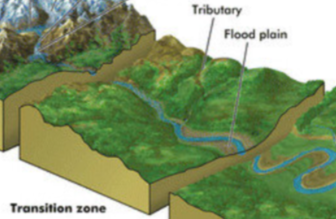Chapter 8 APES Aquatic Biodiversity
1/125
There's no tags or description
Looks like no tags are added yet.
Name | Mastery | Learn | Test | Matching | Spaced |
|---|
No study sessions yet.
126 Terms
Where do Coral reefs form
In clear, warm, coastal water of the tropic and subtropics
What are coral reefs formed by
The are formed by massive colonies of tiny animals called polyps (close relatives of jellyfish). They slowly build reefs by secreting a protective crust of limestone (calcium carbonate) around their soft bodies. When the polyps die, their empty crust remain behinds as a platform for more ___ growth. The results, a elaborate network of crevices, edges, and hole serves as calcium carbonate, “condominiums” for a variety of marine animals.
What mutually beneficial relationship are coral reefs the result of.
The relationship between the polyps and tiny single-celled algae called zooxanthellae that live in the tissues of the polyps. In this example of ______ that algae provide the polyps with food and oxygen through photosynthesis, and helps produce calcium carbonate, which forms the coral’s skeleton. Algae also give the reefs their stunning coloration. The polyps, in turn, provide the algae with a well-protected home and some of their nutrients.
The ecological and economic services that Coral reefs provide.
Even though the coral reefs occupy only about 0.2% of the ocean floor, they provide important services. For example, they act as natural barriers that help to protect 15% of the world’s coastlines from erosion by battering waves and storms. Further, they provide habitats for one-quarter of all marine organisms. Economically, coral reefers produce about one-tenth of the global fish catch— one fourth of the catch in less-developed countries— and they provide fishing and ecotourism jobs for some of the world’s poorest countries. They give us an underwater world to study and enjoy, with each year more than 1 million scuba diver and snorkelers visiting the coral reefs.
What percent of coral reefs are damaged
In a 2008 report by the Global Coral Reef Monitoring Network, scientists estimated that 19% of the world’s coral reefs had been destroyed. Other studies indicated that another 20% of all coral reef ecosystems had been degraded by coastal development, pollution, over-fishing, warmer ocean temperatures, increasing ocean acidity, and other stressed. And another 25-33% of all reefs could be lost withing 20-40 years.
Why are coral reefs vulnerable to damage
Because they grow slowly and disrupt easily.
And they have very small niches: they thrive only in clear and fairly shallow water that consists of high salinity. Runoff of soil and other materials from the land can cloud that water and block sunlight needed by the reefs’ producer organisms. Also, the water in which they live must have a temperature of 18-30 degrees. This explains why the biggest long-term threat to coral reefs may be projected climate change, which could raise the water temperature above this limit in most reef areas. One resulting problem is coral bleaching.
Coral bleaching
Is a resulting problem that Coral reefs face due to rising temperatures, and it occurs when stresses such as increased temperature cause the algae, upon which corals dependent for food, to die off. Without food, the coral polyps then die, leaving behind a white skeleton of calcium carbonate.
Acidity threat to the Coral reefs.
another threat is the increasing ____ of ocean water as it absorbs some of the carbon dioxide produced mostly by the the burning of carbon-containing fossil fuels. The CO2 reacts with ocean water to form a weak acid, which can slowly dissolve the calcium carbonate that makes up the corals.
How much of the earth is covered with water.
Saltwater covers about 71% of the earth’s surface and contains 97% of the earth’s water, and freshwater occupies roughly another 2.2%. Yet, in proportion to the entire planet, it all amounts to a thin precious film of water.
Global ocean
The vast body of water that covers 71% of the Earth and is geographically divided into four large regions—- the Atlantic, Pacific, Arctic, and Indian oceans—-separated by the continents. The largest ocean is the Pacific, which contains more than half of the earth’s water and covers one-third of the earth’s surface.
aquatic life zones
Regions characterized by their distinct aquatic (water) environments: such as oceans, seas, lakes, rivers, or wetlands that can support life. (there are different types of these like there are different types of biomes)
Salinity
The amounts of various salts such as sodium chloride (NaCl) dissolved in a given volume of water. And the distribution of many aquatic organism is determined by the water’s ________. Therefore aquatic life zones are classified into two major types because of their _________: They are either saltwater or marine life zones, and freshwater life zones. For example oceans and estuaries are different types of aquatic life zones but they are both classified as saltwater environments due to their ______.
Saltwater or marine life zones
Are aquatic environments with high salinity, including oceans, coral reefs, and estuaries that support marine organisms.
Freshwater life zones
Are aquatic environments with low salinity, such as rivers, lakes, ponds and inland wetlands, that support organisms adapted to non-salty water.
Plankton
One type of major organisms in saltwater and freshwater life zones, and they are organisms that are too small to swim against the oceans’ currents/ if is carried by tides and currents and cannot swim well enough to move against these forces (weakly swimming, free-floating). And they are divided into three groups.
phytoplankton
Is a type of plankton and they are microscopic, plant-like organism in aquatic ecosystems that perform photosynthesis, producing oxygen and serving as the based of the food chain, and these include many types of algae.
zooplankton
Is a type of plankton and they are tiny animal-like organisms in aquatic ecosystems that drift with currents and they consists of primary consumers (herbivores), which feed on phytoplankton, and secondary consumers, which feed on other ________
ultraplankton
It is the third type of plankton and they are very small photosynthetic bacteria and may be responsible for 70% of the primary productivity near the ocean surface.
nekton
Is the second type of major organisms in saltwater and freshwater life zones and they are strongly swimming consumers such as fish, turtles and whales.
Benthos
Is the third type of major organisms in saltwater and freshwater life zones and they are bottom-dwellers such as: oysters and sea stars, which anchor themselves to ocean bottom structures; clams and worms, which burrow into the sand or mud; and lobsters and crabs, which walks about on the sea floor.
decomposers
Is the fourth major type of organisms in saltwater and freshwater life zones and they are organisms (mostly bacteria), which break down organic compounds in the dead bodies and wastes of aquatic organism into nutrients that aquatic primary produces can use.
What are the key factors in most aquatic systems that determine the types and numbers or organisms found in them.
Temperature, dissolved oxygen content, availability of food, and the availability of light and nutrients required for photosynthesis, such as carbon, nitrogen, and phosphorus.
dissolved oxygen content
the amount of oxygen that is present in water, crucial for the survival of aquatic organisms. High elves of _______ are vital for healthy ecosystems, as they support the respiration of fish, invertebrates, and microorganisms. And what impacts this is the colder water is, the more ___ it can hold. As the water becomes warmer, less _____ can be dissolved in the water.
Euphotic or photic zone
Is the upper layer of aquatic systems, classified by where the sunlight can penetrate.
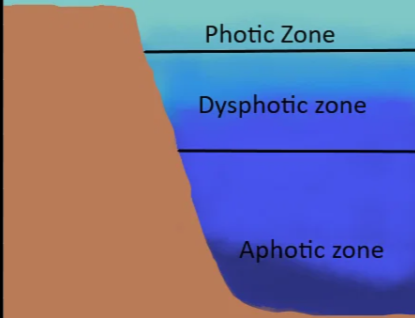
Turbidity
______ is the cloudiness or haziness of a fluid caused by large numbers of individual particles suspended. This can occur natural for example when water is clouded due to excessive algal growths (or algal blooms resulting from nutrient overloads), or can result from disturbances such as clearing of land, which when it rains, causes silt to flow into bodies of water. This is one of the problems plaguing coral reefs, as excessive ______ due to silt runoff prevents photosynthesis and causes the coral to die.
Nutrient availability in different aquatic life zones.
In shallow aquatic systems such as small open streams, lake edges, and ocean shorelines, ample supplies of nutrients for primary producers are usually available. By contrast in most areas of the open ocean, nitrates, phosphates, iron, and other nutrients are often in short supply and this limits net primary productivity.
What does the oceans provide.
It provides enormously valuable ecological and economic services. One estimate of the combined value of these goods and services from all marine coastal ecosystems is over $12 trillion per year, nearly equally to the annual U.S gross domestic product.
The ecological services of Marine ecosystems
Climate moderation, CO2 absorption, Nutrient cycling, waster treatment, Reduced storm impact (mangroves, barrier islands, coastal wetlands) habitats and nursery areas, Genetic resources and biodiversity, Scientific information.
The economic services of Marine ecosystems
They provide food, animal and pet feed, pharmaceuticals, harbors and transportation routs, coastal habitats for humans, recreation, employment, oil and natural gas, minerals, building materials.
How marine ecosystem help sustain the natural Capital
Because Marine aquatic systems are enormous reservoirs of biodiversity. They include many different ecosystems, which host a great variety of species, genes, and biological and chemicals process, thus helping to sustain the four major components of the earth’s biodiversity.
Where is Marine life found
In three major life zones: the coastal zone, the open sea, and the ocean bottom.
Coastal zone
Is one of the major aquatic life zones where marine life is found. And it is the warm, nutrient-rich, shallow water area that extends from the high-tide mark on land to the gently sloping, shallow edged of the continental shelf (the submerged part of the continents). It makes up less than 10% of the world’s ocean area, but it contains 90% of all marine species and is the site of most large commercial marine fisheries.
Why do Most costal zone aquatic system have a high net primary productivity.
These systems like estuaries, coastal marshes, mangrove forest, and coral reefs have a high net primary productivity due to the zones ample supplies of sunlight and plant nutrients that flow from land and are distributed by wind and ocean currents.
Bathyal Zone
Is the middle layer of the open ocean, located between the euphotic zone (where sunlight penetrates for photosynthesis) and the abyssal zone (the deepest, darkest part of the ocean). It is characterized by dim light, cooler temperatures, and low oxygen levels. Very few organisms live here, and it often reffered to as the twilight zone.
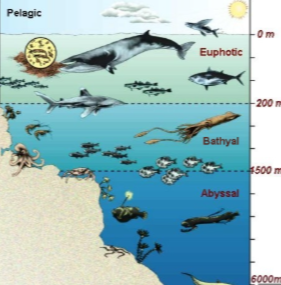
Abyssal zone
Is the deepest part of the open ocean. It is completely dark, cold, and has high pressure. This zone supports limited life, such as specialized organisms like deep-sea fish, giant squids, and bio-luminescent species, often surviving on marine snow (organic matter falling from upper layers)
Thermocline
Is the area in a body of water, such as an ocean, where the temperature drops rapidly with increasing depth. It separates the warmer, mixed surface water from the colder, deeper water below. And in the open sea there is some water between the euphotic zone and the Abyssal Zone in the Bathyal zone.
Estuarine zone
Is the area where freshwater from rivers mixes with saltwater from the ocean, creating brackish water. It is part of the coastal zone and is highly productive, supporting diverse plant and animal life, including fish, shellfish, and migratory birds.
Low tide
Is the point in the tidal cycle when the ocean water level is at its lowest along the shore, exposing more of the shoreline and coastal areas. It occurs due to the gravitation pull of the moon and sun.
High tide
is the point in the tidal cycle when the ocean water level is at its highest along the shore, covering more of the coastline. It is caused by the gravitational pull of the moon and sun on Earth’s oceans.
Open sea/ Open ocean
The part of the Ocean Beyond the continental shelf, where the water is deep and not influenced by coastal processes. And it is divided into zones based on depth and light penetration.
Estuaries
Is a coastal zone aquatic system and it is the area where rivers meet the sea. They are partially enclosed bodies of water where seawater mixes with freshwater as well as nutrients and pollutants from streams, rivers, and runoff from the land.
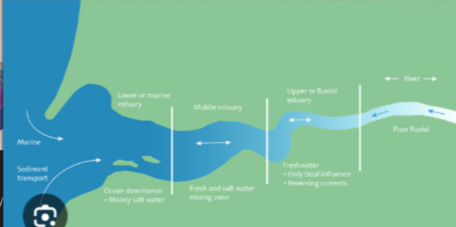
Coastal wetlands
Are low-laying areas along the coast, that are regularly flooded by water/ coast land areas covered with water all or part of the year And they are not completely closed off from the open ocean because they are typically connected to the ocean through tidal flows, which ring in saltwater. They are some of the earths most productive ecosystems because of high nutrient inputs from nearby land, rapid circulation by nutrient’s by tidal waves, and ample sunlight penetrating the shallow waters.
Sea grass beds
Are underwater meadows of at least 60 species of plants that grow in shallow marine and Estuarine areas along most continental coastlines. These highly productive and physically complex systems support a variety of marine species. They also help to stabilize shorelines to help prevent erosion, and reduce wave impacts. Though since 1980 about 29% of the worlds ____________ have been lost to pollution.
Why is life in coastal ecosystems harsh
It is harsh because it must adapt to significantly daily and season changes in tidal and river flows, water temperatures and salinity, and runoff of eroded soil sediment and other pollutant from the land. Because of these stresses, despite the productivity, some coastal ecosystems have low plant diversity composed of a few species that can withstand the daily and seasonal variations.
Mangrove forest
Is a type of coastal wetlands and they are found along some 70% of gently sloping sandy coastlines (the areas where land meets the ocean or sea) in tropical and subtropical regions, especially Australia and southeast Asia. And this forest is mostly dominated by mangroves—-69 different tree species that can grow in salt water. They have extensive root systems that often extend above the water, where they can obtain oxygen and support the trees during period of changing water levels.
The ecological and economic services Mangrove forest provides.
They help to maintain water quality in tropical coastal zones by filtering and absorbing toxic pollutants, excess plant nutrients, and sediments.
They provided food, habitats, and nursery sites for a variety of aquatic and terrestrial species.
They also reduce storm damage and coastal erosion by absorbing waves and storing excess water produced by storms and tsunamis.
Historically, they have sustainably supplied timber and fuel wood to coastal communities.
And loss of mangroves can lead to polluted drinking water, caused by inland intrusion of saltwater into aquifers that are used to supply clean, freshwater.
Despite their services in 2008, the UN estimated that between 1980 and 2005, at least one-fifth of the worlds mangrove forest were lost mostly because of human coast development.
All the coastal zone aquatic systems.
Estuaries: Areas where freshwater from rivers mixes with saltwater from the ocean, creating brackish water.
Salt Marshes: Coastal wetlands dominated by salt-tolerant grasses and pants, often found in temperate zones.
Mangrove Forests: Coastal wetlands in tropical and subtropical regions with salt-tolerant mangrove trees.
Seagrass Beds: Shallow underwater meadows of flowering plants found along coastlines.
Coral reefs: Biodiverse underwater ecosystems found in warm, shallow coastal waters.
Beaches and intertridal zones: Areas between high and low tide that are influenced by wave and tidal action.
Intertidal zone
The gravitational pull of the moon and sun causes tides to rise and fall about every 6 hours in most coastal areas. The area of shoreline between low and high tides is called the ______ ____. Organisms living in this coastal zone aquatic system must be able to avoid being swept away or crushed by waves, and must deal with being immersed during high tides and left high and dry (and much hotter) at low tides. They must also survive changing levels of salinity when heavy rains dilute saltwater. To deal with such stresses, most _____ organisms hold on to something, dig in, or hide in protective shells.
Steep rocky shores
On some coasts, ____ ______ _____ are pounded by waves. The Numerous pools and other habitats in this type of intertidal zone contain a great variety of species that occupy different niches in response to daily and seasonal changes in environmental conditions such as temperature, water flows, and salinity. The definition of this are coastal intertidal zones with rugged cliffs or steep rock formation that drop sharply into the ocean, and they are shaped by strong wave action.
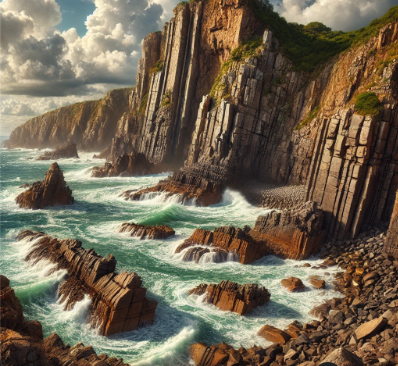
Barrier islands and Sandy shores
Are types of intertidal zones and the first one is: Long, narrow strips of sand that run parallel to the coast, protecting inland areas from waves and storms. And the second one is: Gently sloping beaches made of sand, shaped by waves and tides, home to burrowing organisms like crabs and clams. And these type of intertidal zones supports other types of marine organisms, most of which keep hidden from view and survive by borrowing, or digging, and tunneling in the sand. These ______ ____ and their adjoining coastal wetlands are also home to a variety of shorebirds that have evolved in specialized niches to feed on crustaceans, insects, and other organims’s. Many of these same species also live on barrier islands.
Barrier Islands
Are coastal land forms that are typically made of sand and rise slightly above sea level. They are located parallel to the mainland and act as a protective barrier, shielding the coast from waves, storms, and erosion. And due to their similar environment of certain intertidal zone systems, like barrier beaches and sandy shores.many of these same species on these intertidal zones system are here on ___ _________.
What happens to undistributed Barrie beaches.
They generally have one or more rows of natural sand dunes in which the sand is held in place by the roots of plants, usually grasses. These dunes are the first line of defense against three ravages of the sea. Such Real estate is so scare and valuable that coastal developers frequently remove the productive dunes or build behind the first set of dunes, and cover them with building and roads. Large storms can then flood and even sweep away the seaside construction and severely erode the sandy beaches. Some people incorrectly call these human-influenced events “natural disasters.”
How much homes do coral reefs provide for marine species.
One-fourth of homes for all marine species.
Open sea
is the vast volume of the ocean called the ____ ____. And the sharp increase in water depth at the edge of the continental shelf separates the coastal zone from this. And on the basis of the penetration of sunlight, this deep blue ___ is divided into three vertical zones. But temperatures also change with depth and we can use them to define zones that help to determine species diversity in these layers.
Euphotic zone # 2
Is the brightly lit upper zone of the open sea where drifting phytoplankton carry out about 40% of the world’s photosynthetic activity. Nutrients levels are low and levels of dissolved oxygen are high in the ______ zone. There is one exception to this, however. In areas called upwelling zones, ocean current driven by difference in temperature or by coastal winds bring water up from the abyssal zone. Upwelling carry nutrients from the ocean bottom to the surface for use by producers, and thus these zones contain high levels of nutrient. Large, fast-swimming predatory fishes such as swordfish, sharks, and bluefin tuna populate the _____ zone. They fed on secondary and higher-level consumers, which are supported directly or indirectly by producers.
Bathyal zone # 2
Is the dimly lit middle zone of the open sea, and it receives little sunlight and therefore does not contain photosynthesizing producers. Zooplankton and smaller fishes, many of which migrate to feed on the surface at night, populate this zone.
Abyssal zone # 2
Is the lowest zone of the open sea and it is dark and very cold. There is no sunlight to support photosynthesis, and this zone has little dissolved oxygen due to low biological activity and oxygen replenishment since there is limited photosynthesis to produce oxygen and oxygen from the surface takes a long time to reach this zone. Paired with the microbial activity responsible for decomposition reduces the dissolved oxygen levels. Nevertheless, the deep ocean floor is teeming with life—so much that is it considered a major life zones—- because it contains enough nutrients to support a large number of species.
Marrine snow
Most organisms of the deep waters and ocean floor get their food from showers of dead and decaying organisms—called ______ ____- drifiting down from upper, lighter levels of the ocean.
Deposit feeders
Are organisms that eat organic matter and nutrients found in soil or sediment. Some abyssal-zone organisms, including many types of worms are this, and they take mud into their guts and extract nutrients from it.
Filter feeders
Are organisms that strain small food particles and nutrients from water. For example some abyssal-zone organisms like oysters, clams, and sponges are this, and they pass water through or over their bodies and extract nutrients from it.
Net primary productivity in the open sea.
Net primary productivity is quiet low in the open sea, except in upwelling areas. However, because the open sea covers so much of the earth’s surface, it makes the largest contribution to the earth’s overall NPP.
What percent of the worlds ocean area has human heavily affected.
In 2008, the U.S National center for Ecological Analysis and Synthesis used computer models to analyze and provide the first-ever comprehensive map of the effects of 17 different types of human actives on the world’s oceans. And in the 4-year study, an international team of scientist found that ____ ____ affected 41% of the world’s ____ ___.
In 2010 how much of the World’s and U.S population lived along or near the coasts.
45% of the world’s population and more than half of the U.S populations. And these percentages are increasing rapidly.
First major threats to marine systems from human actives
First, Coastal development, which destroyes and pollutes coastal habitats.
Second major threats to marine systems from human activities
second, runoff of nonpoint sources of pollutants such as silt, fertilizes, pesticides, and livestock wastes.
Third major threat to marine systems from human activities
Third is, point-source pollution such as sewage from cruise ships and spills for oil tankers.
Fourth major threat to marine systems from human activities
fourth, Pollution and degradation of coastal wetlands and estuaries.
Fifth major threat of marine system from human activities.
Fifth, over fishing, which depletes populations of commercial fish species.
Sixth major threat to marine systems from human activities.
sixth, is the use of fishing trawlers, which drag weighted nets across the ocean bottom, degrading and destroying its habitats.
Seventh major threat to marine systems from human activities.
seventh is Invasive species, introduced by humans, that can deplete populations of native aquatic species and cause economic damage.
Eight major threats to marine systems from human activities.
eight, Climate change, enhanced by human activities, which is warming the oceans and making them more acidic; this could cause a rise in sea levels during this century that would destroyed coral reefs ND flood coastal marshes and coastal cities.
Major human impacts on Marine ecosystems
Half of coastal wetlands lost to agriculture and urban development. Over one-fifth of mangrove forests lost to agriculture, development, and shrimp farms since 1980. Beaches eroding because of coastal development and rising sea levels. Ocean bottom habitats degraded by dragging and trawler fishing. At least 20% of coral reefs severely damaged and 25-33% more threatened.
Major human impacts on coral reefs
Ocean warming, Rising ocean acidity, Soil Erosion, Algae growth from fertilized runoff, Bleaching, Rising sea levels, Increased UV exposures, Damage from anchors, Damage from fishing and diving.
Bay
is a body of water partially surrounded by land, with a wide opening to the sea.
The Chesapeake bay
It is the largest estuary in the United States and since 1960 it has been in serious trouble from water pollution, mostly because of human actives. One problem is population growth. Between 1940 and 2007, the number of people living in the ___________ ___ area grew from 3.7 million to 16.8 million, and could reached 18 million by 2020, according to 2009 estimates by.
Where does the Chesapeake Bay estuary receives it’s waste from.
From point and non-point sources scattered through a high drainage basin (is an area of land at a high elevation where water, like rain or snow melt, collects and flows downhill into rivers, streams, or other bodies of water) in parts of six states and the District of Columbia. The bay has become a hug pollution sink because only 1% of the waste entering it is flushed into the Atlantic Ocean. It is also so shallow that people can wade through much of it. In addition, runoff of sediment, mostly from soil erosion, harms the submerged grasses needed by crabs and young fish. Runoff also increase when tress near the bay area cut down for development.
How does the increased phosphate and nitrate levels impact the Chesapeake bay
Due to the waste from point and non-point sources scattered through high drainage basins, phosphate and nitrate levels have risen sharply in many parts of the bay, causing algal blooms and oxygen depletion. Point sources primarily sewage treatment plants and industrial plants (often in violated of their discharge permits) account for 60% by weight of the phosphates. Non point sources—-mostly runoff of fertilizer, animal waster from urban, suburban, and agricultural land, and deposition of pollutants from the atmosphere—account for 60% by weight of the nitrates.
What happen to Chesapeake bay Oysters and crabs.
Commercial harvests of the bay’s once abundant oysters and crabs, as well as several important fish species, have fallen sharply since 1960 because of a combination of pollution, over fishing, and disease in this bay.
The oysters keystone role in the Chesapeake bay.
A century ago, oysters were so abundant that they filterd and cleaned the Chesapeake’’s entire volume of water every 3 days. This important form of natural Capital provided by these keystone species helped removed or reduce excess nutrients and algal bloom, both of which lead to decreased levels of dissolved oxygen. Now the oyster population has been reduced to the point where this filtration process takes a year and the keystone role of this species has been severely weakened. Though in 2009, researches at the Virginia institute of Marine science and at the college of William and Mary reported that several protected experimental reefs created in 2004 are now home to a significant population of oysters. This research suggest that creating thoughts of such reefs as oyster sanctuaries would help to raise the overall oyster population. This could also help to clean the water and provide more habits for crabs, fish, and other forms of marine life.
Chesapake Bay program.
In 1983, the United States implemented this. In this ambitious attempt to integrated coastal management, citizens groups, communities, state legislatures, and the federal government worked together to reduce pollution inputs into the bay. One stragey was to establish land-use regulations to reduce agricultural and urban runoff in the six states that form the bay’s drainage area. Other strategies included banning phosphate detergents, upgrading sewage treatment plants, and monitoring industrial discharges more closely. In addition, some adjoining wetlands were restored and larger areas of the bay were replanted with sea grasses to help filter out excessive nutrient and other pollutants.
The aftermath of the Chesapeake Bay program
By 2008, despite 25 years of effort costing almost $6 billion, the program had failed to meed its goals. This was because of increased population and development, a drop in state and federal funding, and lack of cooperation and enforcement among local, state, and federal officials. In 2008, the Chesapeake Bay foundation reported that the bay’s water quality was “very poor” and only 21% of the established goals had been met. There are some sings of hope for this Bay as in 2009 President Obama signed an executive order directing the Environmental protection Agency to take charge of a new federal effort to revitalize the Chesapeake and to use its full authority under the Clean water act to help clean it up. The order also called for reducing inputs from agriculture and for development of a stragey to deal with threats from projected climate change. However it will require considerable funding.
The importance of Freshwater life zones.
These life zones that include standing (water systems that don’t flow or move) bodies of freshwater such as lakes, ponds, and inland wetlands. And flowing (are water systems that move in a specific direction) systems such as streams and rivers. And although these freshwater systems cover less then 2.2% of the earth’s surface, they provide a number of importation ecological and economic services.
Lakes
Are large natural bodies of standing freshwater formed when precipitation, runoff, stream, rivers, and groundwater seepage fill depression in the earth’s surface. Causes of such depression include glaciation, displacement of the earth's crust, and volcanic activity. Drainage areas on surround land supply ____ with water from rainfall, melting snow, and streams. These _____ vary tremendously in size, depth, and nutrient content. Deep ___ normally consist of four distinct zones that are defined by their depth and distance from shore.
Littoral zone
It is the top layer of Freshwater lakes, and it is near the shore and consists of the shallow sunlit water to the depth at which rooted plants stop growing. It has a high biological diversity because of ample sunlight and inputs of nutrient from the surrounding land. Species living in the ____ ___ include many rooted plants, animals, such as turtles, frogs, and crayfish, and fish such as bass perch and carp.
Limnetic zone
The next layer in the freshwater lake is this zone, and it is categorized by the open, sunlit surface layer away from the shore that extends to the depth penetrated by sunlight. Is the main photosynthetic zone of the lake, this layer produced to food and oxygen that support most of the lake’s consumers. It’s most abundant organisms are microscopic phytoplankton and zooplankton. Some large species of fish spend most of their time in this zone, with occasional visits to the littoral zone to feed and reproduce.
Profundal zone
Is the third deepest layer in Freshwater lakes, and it is a layer of deep, open water where it is took dark for photosynthesis. Without sunlight and plants, oxygen levels are often low here. Fishes adapted to the lakes cooler and darker water are found in this zone.
Benthic zone
It is the bottom layer of Freshwater lakes and it is inhabited mostly by decomposers, detritus feeders, and some species of fish (bethos). The ____ __ is nourished mainly by dead matter that falls from the littoral and limnetic zones and by sediment washing into the lake.
Oligotrophic Lakes
Ecologists classify lakes according to their nutrient content and primary productivity. Lakes that have a small supply of plant nutrients are called this. This type of lake is often deep and have steep banks.
Because these lakes are often found in ares with rock or Sandy terrain they don’t easily release nutrients into the water. Even though the terrains allow some runoff, they also reduce the surface area for nutrient-rich soil to accumulate.
Since these types of lakes are usually deep and cold, this slows down biological activity decomposition—-process that release nutrient into the water.
And steep banks often lack dense vegetation, which means there is less organic matter washing into the lake.
Glacier and mountain streams supply water to many such lakes, bringing little in the way of sediment or microscopic life to cloud the water.
So these lakes usually have crystal-clear water and small population of phytoplankton and fish species. And because of their low levels of nutrients, these lakes have a low net primary productivity.
Eutrophic lake
Is a lake with a large supply of nutrients needed by produces. Because of their high levels of nutrients, these lakes have a high net primary productivity.
How is bottom sediment formed in oligotrophic lakes
Over time, sediment, organic material, and inorganic nutrients wash into most oligotrophic lakes, and plants grow and decompose to form bottom sediments.
What is the typically environment of Eutrophic lakes
They are typically shallow and have murky brown or green water with high turbidity, since they have high levels of nutrients (particularly nitrogen and phosphorus, which often come from agriculture runoff, sewage, or other human activities.) they promote the rapid growth of algae and aquatic plants. Also as algae and aquatic plants die, they sink to the bottom and decompose and since these lakes are typically shallow the decomposition of these organic matter is more faster because oxygen is able to reach the decomposers more easily, it leads to a faster rates of the suspend particles from the decomposed sediments. Lastly since the decomposition of organic matter consumes dissolved oxygen in the lake, which can lead to anoxic conditions. This limits the survival of aquatic organisms that help maintain water clarify, like certain types of fish and filter feeders.
Cultural eutrophication
The processes of when human inputs of nutrients from the atmosphere and from nearby urban and agricultural ares accelerate the eutrophication of lakes. This process often puts excessive nutrients into lakes.
Mestrophic lakes.
Most lakes are this because they fall between the two extremes of nutrient enrichment.
Surface water
Precipitation that does not sink into the ground or evaporate.
Runoff
When surface water flows into streams.
Watershed or Drainage Basin
Is an area of land where all the surface water, from rain or snow, drains into a common body of water/ Is the land area that delivers runoff, sediment, and dissolved substances to a stream. Small streams joint to form rivers, and river flow downhill to the ocean.
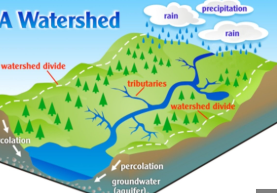
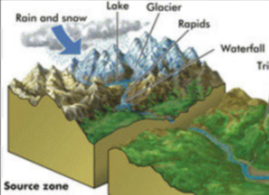
The source zone
Is one of the three aquatic life zones where the downward flow of surface water and groundwater from mountain Highlands to the sea typically takes place. In this narrow area, headwater, or highland streams are usually shallow, cold, clear, and swiftly flowing.
This properties of water in the source zone.
In this zone, as the turbulent water flows and tumbled downward over obstacles like rocks, waterfalls, and rapids. It dissolved large amounts of oxygen from the air. Most of these streams are not very productive because of a lack of nutrients and primary producers. Their nutrient come primarily from organic matter (mostly leaves, branches, and the bodies of living and dead insects) that falls into the stream from nearly land.
What type of animals populate the soruce zone.
This zone is populated by cold-water fish species (such as trout in some areas), which need lost of dissolved oxygen. Many fishes and other animals in fast-flowing headwaters streams have compact and flattend bodies that allow them to live under stones. Others have streamline and muscular bodes that allow them to swim in the rapid, strong currents. Most of the plants in this zone are algae and mosses attached to rock and other surfaces under water.
Transition zone
In this zone, which is the middle section of a watershed, streams form the headwaters merge to form wider, deeper, and warmer streams that flow down gentler slopes with fewer obstacles. They can be more turbid (from suspended sediment), slower flowing, and can have less dissolved oxygen than headwaters streams. The warmer water and other conditions in this zone support more producers as well as cool-water and warm-water fish species (such as black bass) with slightly lower oxygen requirements. As streams flow downhill, they shape the land through which they pass. Over millions of years, the friction of moving water has leveled mountains and cut deep canyons, and rocks and soil removed by the water have been deposed as sediment in low-lying areas.
